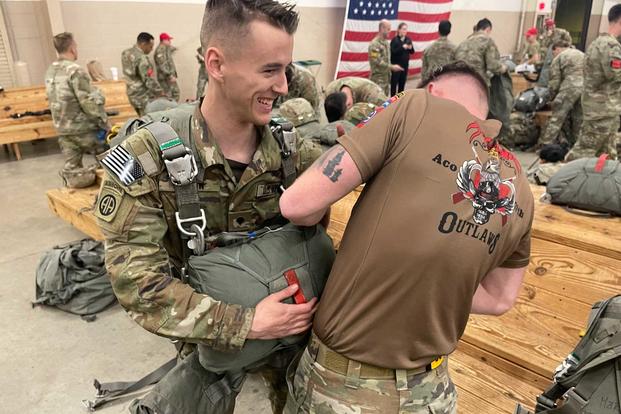A group of mostly junior Army infantrymen and noncommissioned officers sat in a staging area Thursday, waiting to put on their parachutes for a nighttime jump into the Holland Drop Zone at Fort Bragg, North Carolina. They were eating french fries and burgers -- a heavy meal they hoped would sustain them the whole night.
"Hopefully, eating all this doesn't cause the plane to fall from the sky," one 82nd Airborne trooper joked.
The routine training exercise was planned far in advance and is unrelated to the crisis in Eastern Europe. Soldiers may jump as often as once a month.
Read Next: Size and Scope of Fresh US Troop Presence in Europe Meant to Deter Russia Stirs Debate in Congress
But it also comes as 2,000 Fort Bragg service members are in the midst of a historic deployment to Europe after Russian President Vladimir Putin surrounded Ukraine with some 130,000 troops. Despite a Biden administration announcement calling for a rapid activation of Fort Bragg forces, most have yet to deploy and it is unclear what the timetable is for those activations.
Paratroopers at Fort Bragg have been very busy. Last year, 82nd Airborne soldiers rapidly deployed to Kabul, Afghanistan, as that nation crumbled and fell under Taliban rule after two decades of war.
Soldiers showed up at 5 p.m. to conduct rehearsals of the Thursday jump from a mock aircraft. Safety is paramount with any Army training, but when soldiers are jumping out of a perfectly good aircraft at night with limited visibility, everything down to how the soldiers hold their static lines is gone over meticulously.
"I got into a couple freaky accidents," another junior soldier explained, lifting up his shirt to show scarring on his arm. He was injured after "swimming" his static line -- meaning his arm got caught in the line that opens his parachute, something he explained is "very painful."
"But we still do it," he added. "We do more than most units. We put our lives on the line a lot."
Soldiers interviewed all agreed there was at least some level of nervousness before a jump. There's pride within the 82nd's ranks, serving in the division tasked with being America's shock troops -- and being set to possibly deploy anywhere in the world with little notice.
"My mom does not like it," another junior trooper said, laughing about it. "She has seen a jump before. To me, it's cool, but she gets scared every time I tell her about it."
Jumps are some of the military's most dangerous training events. Between 2010 and 2015, 13 soldiers died while conducting parachute training operations, according to a study by the Aerospace Medical Association. Most of those deaths occurred during static-line jumps from C-17 Globemaster transport aircraft, and 33% of fatalities were the result of "improper or abnormal exit" and "unstable or improper body position."
The study also notes that 11% of the fatalities were from "entanglement, parachute malfunction" and troops being "dragged on top of the drop zone," while 6% were static-line injuries or drop-zone hazards. In 69% of cases, blunt force trauma was the cause of death.
Just seven hours before Thursday's jump, the first group of Bragg troops mobilized to Europe. More deployments are planned in the coming days in an effort to reaffirm President Joe Biden's commitment to NATO and deter the Russian threat.
"Every time we're needed, we'll be ready," a junior infantry paratrooper said. "I went to Afghanistan. We are the unit that was there when the war started and when it ended."
-- Steve Beynon can be reached at Steve.Beynon@military.com. Follow him on Twitter @StevenBeynon.
Related: 'It's Excited Nervousness': First Wave of US Troops Heads to Europe as Russia Eyes Ukraine













